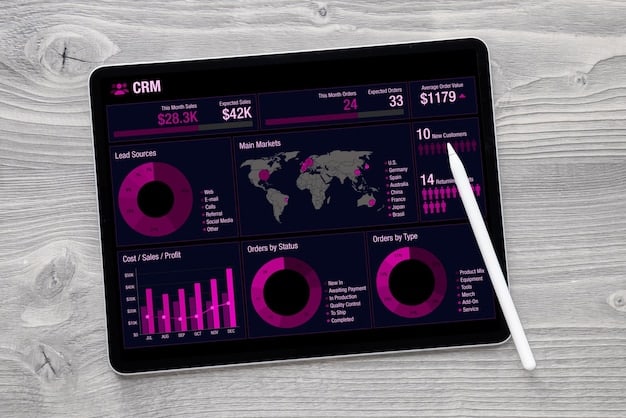Payment Analytics: Optimize US E-commerce Processing with Data

Payment analytics empowers US e-commerce businesses to optimize their payment processing strategies by leveraging data-driven insights for improved efficiency, reduced costs, and enhanced customer experiences.
In today’s competitive e-commerce landscape, understanding and optimizing payment processing is critical for success. Payment analytics: Using data to optimize your payment processing strategy for US e-commerce provides the insights needed to make informed decisions, reduce costs, and improve the customer experience.
Understanding the Basics of Payment Analytics
Payment analytics involves collecting and analyzing data related to payment transactions to gain actionable insights. This data encompasses various aspects of the payment process, from transaction volume and processing fees to fraud detection and customer payment preferences. By understanding these basics, businesses can begin to unlock the power of data-driven payment optimization.
Key Metrics in Payment Analytics
Identifying and tracking key metrics is essential for effective payment analytics. These metrics provide a comprehensive view of payment processing performance and help pinpoint areas for improvement.
- Transaction Volume: The total number of transactions processed within a given period.
- Decline Rates: The percentage of attempted transactions that are declined by the payment processor or bank.
- Processing Fees: The costs associated with processing each transaction, including interchange fees and processor markup.
- Fraud Rates: The percentage of fraudulent transactions detected and prevented.
Benefits of Implementing Payment Analytics
Implementing payment analytics offers numerous benefits for US e-commerce businesses, including cost reduction, improved efficiency, and enhanced customer satisfaction.
By monitoring these metrics, businesses can identify trends, diagnose problems, and implement solutions to improve their payment processing performance. This leads to cost savings, reduced fraud, and a better customer experience.

In conclusion, understanding the basics of payment analytics, including key metrics and benefits, is the first step towards optimizing payment processing strategies for US e-commerce businesses. By leveraging data-driven insights, businesses can reduce costs, improve efficiency, and enhance customer satisfaction.
Setting Up Your Payment Analytics Infrastructure
Setting up a robust payment analytics infrastructure is crucial for effectively collecting, analyzing, and visualizing payment data. This infrastructure typically involves integrating various data sources, selecting appropriate analytics tools, and establishing data governance policies. Let’s explore the setup process in more detail.
Integrating Payment Data Sources
Integrating various payment data sources is essential for a comprehensive view of payment processing performance. These data sources may include payment gateways, merchant accounts, and fraud detection systems.
By integrating these data sources, businesses can consolidate their payment data into a single repository for analysis. This provides a holistic view of payment processing performance and facilitates the identification of trends and patterns.
Choosing the Right Analytics Tools
Selecting the right analytics tools is critical for effectively analyzing payment data and generating actionable insights. These tools should be capable of handling large volumes of data, performing complex calculations, and generating visualizations.
- Data Visualization Tools: Tools that present data in a graphical format, making it easier to understand and interpret.
- Business Intelligence Platforms: Comprehensive platforms that offer a range of analytics capabilities, including data integration, analysis, and reporting.
- Custom Analytics Solutions: Tailored solutions that are specifically designed to meet the unique needs of a business.
By using the right analytics tools, businesses can unlock the full potential of their payment data and make more informed decisions about their payment processing strategies.

In conclusion, setting up a payment analytics infrastructure involves integrating payment data sources, selecting appropriate analytics tools, and establishing data governance policies. By following these steps, businesses can establish a robust foundation for data-driven payment optimization.
Optimizing Payment Gateway Selection with Analytics
Choosing the right payment gateway is a critical decision for any e-commerce business. With numerous options available, each offering different features, pricing models, and levels of security, analytics can play a crucial role in making an informed choice. Understanding how analytics can optimize payment gateway selection is essential for minimizing costs and maximizing performance.
Comparing Payment Gateway Performance
Analytics allows businesses to compare the performance of different payment gateways based on key metrics such as transaction success rates, processing fees, and settlement times. This data-driven approach helps identify the gateway that best aligns with the business’s specific needs.
By monitoring these metrics, businesses can identify gateways that consistently deliver high performance and reliability.
Understanding Transaction Success Rates
Transaction success rates are a critical metric for evaluating payment gateway performance. A high success rate indicates that transactions are processed smoothly and efficiently, minimizing customer frustration and lost sales.
- Analyzing success rates across different payment methods and customer segments.
- Identifying and addressing common causes of failed transactions.
- Optimizing payment gateway configurations to improve success rates.
Improving transaction success rates can have a significant impact on revenue and customer satisfaction.
In conclusion, optimizing payment gateway selection with analytics involves analyzing key performance metrics, understanding transaction success rates, and comparing pricing models. By leveraging data-driven insights, businesses can choose the gateway that best aligns with their needs and maximize the efficiency and cost-effectiveness of their payment processing operations.
Reducing Fraud and Chargebacks with Payment Data
Fraud and chargebacks are significant challenges for e-commerce businesses, leading to financial losses and reputational damage. Payment data can be a powerful tool in mitigating these risks. By analyzing transaction patterns, identifying suspicious activity, and implementing proactive fraud prevention measures, businesses can significantly reduce their exposure to fraud and chargebacks.
Identifying Fraudulent Transaction Patterns
Payment analytics can help identify fraudulent transaction patterns by analyzing various data points, such as transaction amounts, IP addresses, and billing addresses. This allows businesses to detect suspicious activity and take proactive measures to prevent fraud.
By analyzing these data points, businesses can identify patterns that are indicative of fraudulent activity.
Implementing Proactive Fraud Prevention Measures
Based on insights from payment data analysis, businesses can implement proactive fraud prevention measures, such as address verification systems (AVS), card verification value (CVV) checks, and fraud scoring systems.
- Using AVS to verify the billing address provided by the customer.
- Implementing CVV checks to ensure that the customer has physical possession of the card.
- Using fraud scoring systems to assign a risk score to each transaction, based on various factors.
These measures can help prevent fraudulent transactions from being processed in the first place.
In conclusion, reducing fraud and chargebacks with payment data involves identifying fraudulent transaction patterns and implementing proactive fraud prevention measures. By leveraging data-driven insights, businesses can significantly reduce their exposure to fraud and protect their bottom line. Understanding and addressing these issues is crucial for maintaining a healthy and profitable e-commerce operation.
Improving Customer Experience Through Payment Data Insights
In today’s competitive e-commerce market, customer experience is paramount. Payment data can provide valuable insights into customer preferences, behaviors, and pain points, enabling businesses to optimize the payment process and enhance overall customer satisfaction. Tailoring payment options, streamlining the checkout process, and addressing common payment issues is essential for creating a seamless and enjoyable shopping experience.
Tailoring Payment Options to Customer Preferences
Payment data can reveal which payment methods are most popular among different customer segments, allowing businesses to tailor their payment options to meet customer preferences.
By offering a variety of payment options, businesses can cater to the diverse needs of their customer base and improve conversion rates.
Streamlining the Checkout Process
Payment analytics can identify bottlenecks and pain points in the checkout process, allowing businesses to streamline the experience and reduce cart abandonment rates.
- Simplifying the checkout form and reducing the number of required fields.
- Offering guest checkout options for customers who don’t want to create an account.
- Providing clear and concise instructions throughout the checkout process.
A streamlined checkout process can significantly improve customer satisfaction and drive sales.
In conclusion, improving customer experience through payment data insights involves tailoring payment options to customer preferences and streamlining the checkout process. By leveraging data-driven insights, businesses can create a seamless and enjoyable shopping experience that fosters customer loyalty and drives revenue growth.
Future Trends in E-commerce Payment Analytics
The field of e-commerce payment analytics is constantly evolving, with new technologies and trends emerging to help businesses optimize their payment processing strategies. Staying informed about these future trends is crucial for maintaining a competitive edge and maximizing the benefits of payment analytics. Let’s explore some of the key trends shaping the future of e-commerce payment analytics.
Real-Time Payment Analytics
Real-time payment analytics enables businesses to monitor payment transactions in real-time, allowing them to identify and respond to issues as they arise. This provides greater visibility and control over the payment process.
With real-time analytics, businesses can quickly detect fraudulent transactions, identify payment gateway outages, and address customer payment issues.
AI-Powered Payment Optimization
Artificial intelligence (AI) and machine learning (ML) are increasingly being used to automate and optimize various aspects of payment processing, from fraud detection to payment routing.
- Using AI to identify and prevent fraudulent transactions in real-time.
- Optimizing payment routing to minimize processing fees and improve transaction success rates.
- Personalizing payment options based on customer preferences and behaviors.
AI-powered payment optimization can significantly improve efficiency and reduce costs.
In conclusion, future trends in e-commerce payment analytics include real-time payment analytics and AI-powered payment optimization. By embracing these trends, businesses can unlock new opportunities for growth and innovation in the ever-evolving world of e-commerce.
| Key Point | Brief Description |
|---|---|
| 📊 Metrics | Transaction volume, decline rates, and fraud rates crucial for analysis. |
| 🌐 Integration | Integrating payment data sources provides a holistic view. |
| 🛡️ Fraud | Payment data can identify and prevent fraudulent transactions. |
| ⭐ Customer Experience | Insights improve payment options and checkout processes. |
FAQ Section
What is payment analytics and why is it important?
▼
Payment analytics involves analyzing payment transaction data to gain insights for optimizing payment processing, reducing costs, and improving customer experience. It’s vital for data-driven decision-making in e-commerce.
Why should I track transaction success rates?
▼
Tracking transaction success rates helps identify and address issues causing failed transactions, improving revenue and customer satisfaction by ensuring smooth payment processing.
Why is it important to implement fraud prevention measures?
▼
Implementing fraud prevention measures protects your business from financial losses and reputational damage. Payment analytics helps detect and prevent fraudulent activities, securing your revenue streams.
How can I improve the checkout process using payment analytics?
▼
Payment analytics identifies bottlenecks in the checkout process. Streamlining the checkout form and offering guest checkout options reduces cart abandonment and improves customer satisfaction.





